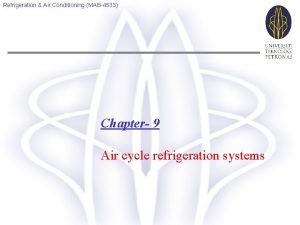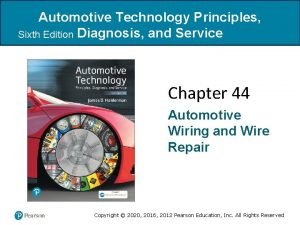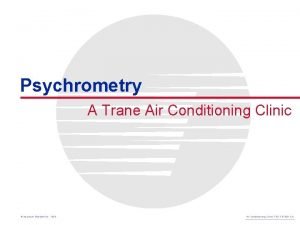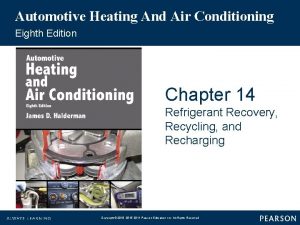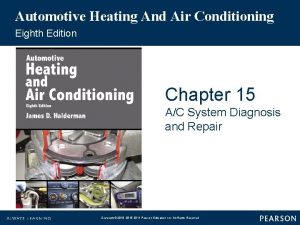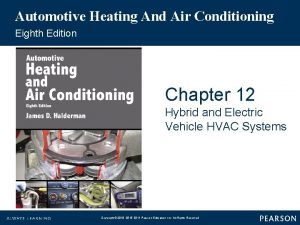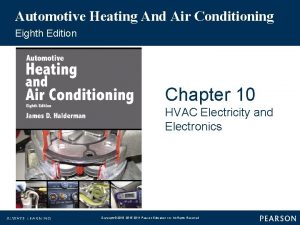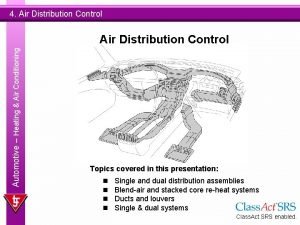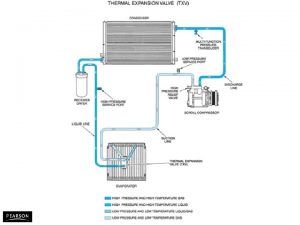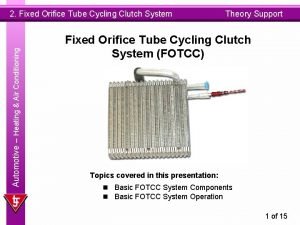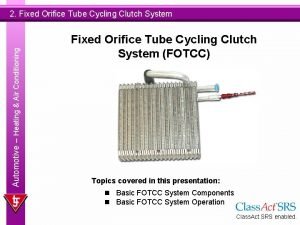Automotive Heating And Air Conditioning Eighth Edition Chapter










































- Slides: 42

Automotive Heating And Air Conditioning Eighth Edition Chapter 9 Heating System Operation and Diagnosis Copyright © 2018, 2015, 2011 Pearson Education, Inc. All Rights Reserved

Learning Objectives (1 of 2) 9. 1 Prepare for the ASE Heating and Air Conditioning (A 7) certification test content area “C” (Heating and Engine Cooling Systems Diagnosis and Repair). 9. 2 Discuss the operation of heating systems. 9. 3 Discuss the diagnosis of heating systems. Copyright © 2018, 2015, 2011 Pearson Education, Inc. All Rights Reserved

Learning Objectives (2 of 2) 9. 4 Explain the operation of electrically heated seats. 9. 5 Explain the operation of heated and cooled seats. 9. 6 Explain the operation of heated steering wheel. Copyright © 2018, 2015, 2011 Pearson Education, Inc. All Rights Reserved

Heating Systems (1 of 2) • The inlet hose to the heater core connects to an outlet fitting near the engine thermostat, or an area of the engine with the hottest coolant. • The outlet hose from the heater core is connected near the inlet of the water pump, which is the area with the lowest coolant pressure. Copyright © 2018, 2015, 2011 Pearson Education, Inc. All Rights Reserved

Heating Systems (2 of 2) • When the engine runs, coolant flows through the engine’s water jackets, past thermostat, and through the heater core. • The heated coolant warms the heater core and the air passing through it. Copyright © 2018, 2015, 2011 Pearson Education, Inc. All Rights Reserved

FIGURE 9– 1 The main parts of a vehicle’s heating system are the heater core, blower, heater hoses, and, in some cases, a heater control valve. Copyright © 2018, 2015, 2011 Pearson Education, Inc. All Rights Reserved

Dual Heating Systems • Larger vehicles with rear A/C systems include a heater in the rear unit. – These rear units include a heater core and temperature -blend door. – Heater hoses Copyright © 2018, 2015, 2011 Pearson Education, Inc. All Rights Reserved

Heater Diagnosis (1 of 5) • Visual Inspection – Coolant level and condition – Water pump drive belt condition and proper tension § § Belt tension gauge Marks on the tensioner Torque wrench reading Deflection Copyright © 2018, 2015, 2011 Pearson Education, Inc. All Rights Reserved

Heater Diagnosis (2 of 5) • To check a radiator or condenser for possible clogged or restricted areas – Check the temperature of the heater hoses – Check for proper airflow across the heater core – Pressure test the cooling system Copyright © 2018, 2015, 2011 Pearson Education, Inc. All Rights Reserved

Heater Diagnosis (3 of 5) • Scan Tool Diagnosis – Use a scan tool and check for any stored or pending diagnostic trouble codes, especially those that pertain to the HVAC controls. Copyright © 2018, 2015, 2011 Pearson Education, Inc. All Rights Reserved

Heater Diagnosis (4 of 5) • Scan Tool Diagnosis – Check that the coolant temperature as measured by the engine coolant temperature (ECT) sensor is correct, usually 180°F to 200°F (82°C to 93°C). Check service information for the specified coolant temperature for the vehicle being checked. Copyright © 2018, 2015, 2011 Pearson Education, Inc. All Rights Reserved

Heater Diagnosis (5 of 5) • Scan Tool Diagnosis – Perform a bidirectional control of the blend door and blower motor speed, if possible, to confirm that these are operating correctly. Copyright © 2018, 2015, 2011 Pearson Education, Inc. All Rights Reserved

FIGURE 9– 4 A special wrench being used to remove the tension from the accessory drive belt so it can be removed. Copyright © 2018, 2015, 2011 Pearson Education, Inc. All Rights Reserved

Electrically Heated Seats (1 of 3) • Heated seats use electric heating elements in the seat bottom, as well as in the seat back in many vehicles. • The heating element is designed to warm the seat and/or back of the seat to about 100°F (37°C) or close to normal body temperature (98. 6°F). Copyright © 2018, 2015, 2011 Pearson Education, Inc. All Rights Reserved

Electrically Heated Seats (2 of 3) • A temperature sensor in the seat cushion is used to regulate the temperature. • The sensor is a variable resistor that changes with temperature and is used as an input signal to a heated seat control module. Copyright © 2018, 2015, 2011 Pearson Education, Inc. All Rights Reserved

Electrically Heated Seats (3 of 3) • The heated seat module uses the seat temperature input, as well as the input from the high–low (or variable) temperature control, to turn the current on or off to the heating element in the seat. • Some vehicles are equipped with heated seats in both the rear and the front. Copyright © 2018, 2015, 2011 Pearson Education, Inc. All Rights Reserved

FIGURE 9– 6 The heating element of a heated seat is a replaceable part, but service requires that the upholstery be removed. The yellow part is the seat foam material and the entire white cover is the replaceable heating element. This is then covered by the seat material. Copyright © 2018, 2015, 2011 Pearson Education, Inc. All Rights Reserved

Heated and Cooled Seats (1 of 2) • Most electrically heated and cooled seats use a thermoelectric device (TED) located under the seat cushion and seat back. • The thermoelectric device uses the Peltier effect. • Most vehicles equipped with heated and cooled seats use two modules per seat. Copyright © 2018, 2015, 2011 Pearson Education, Inc. All Rights Reserved

Heated and Cooled Seats (2 of 2) • Each thermoelectric device has a temperature sensor, called a thermistor. • The control module uses sensors to determine the temperature of the fins in thermoelectric device so the controller can maintain the set temperature. Copyright © 2018, 2015, 2011 Pearson Education, Inc. All Rights Reserved

FIGURE 9– 7 A Peltier effect device is capable of heating or cooling, depending on the polarity of the applied current. Copyright © 2018, 2015, 2011 Pearson Education, Inc. All Rights Reserved

Heated Steering Wheel (1 of 2) • A signal is sent to the control module and electrical current flows through the heating element in the rim of the steering wheel. • The system remains on until the ignition switch is turned off or the driver turns off the control switch. Copyright © 2018, 2015, 2011 Pearson Education, Inc. All Rights Reserved

Heated Steering Wheel (2 of 2) • The temperature of the steering wheel is usually calibrated to stay at about 90°F (32°C), and it requires three to four minutes to reach that temperature depending on the outside temperature. Copyright © 2018, 2015, 2011 Pearson Education, Inc. All Rights Reserved

FIGURE 9– 8 The heated steering wheel is controlled by a switch on the steering wheel in this vehicle. Copyright © 2018, 2015, 2011 Pearson Education, Inc. All Rights Reserved

Summary • The heater core resembles a small radiator, and it is connected to the engine by a pair of hoses. • Heated seats can use either a resistance type heater located under the seat covering or a thermoelectric (TE) device. • Heater diagnosis includes verifying the problem, visual inspections and scan tool usage. Copyright © 2018, 2015, 2011 Pearson Education, Inc. All Rights Reserved

1 The diagnosis of a lack of heat from the heater started by checking the temperature of the heater hoses. The return hose was colder than the inlet hose. Copyright © 2018, 2015, 2011 Pearson Education, Inc. All Rights Reserved

2 A test strip was used to check the coolant p. H and freezing point. The coolant did not look fresh, but the test strip results were normal. Copyright © 2018, 2015, 2011 Pearson Education, Inc. All Rights Reserved

3 The refractometer test confirmed that the freezing protection was – 32°F (– 36°C). Copyright © 2018, 2015, 2011 Pearson Education, Inc. All Rights Reserved

4 The heater core was flushed and the coolant flow through the hoses seemed to be normal. Copyright © 2018, 2015, 2011 Pearson Education, Inc. All Rights Reserved

5 The heater core had to be removed and this required that the dash assembly be removed. Starting to remove the dash components to get access to the heater core. Copyright © 2018, 2015, 2011 Pearson Education, Inc. All Rights Reserved

6 The fasteners used to retain the dash to the bulkhead being removed. Copyright © 2018, 2015, 2011 Pearson Education, Inc. All Rights Reserved

7 The A/C system was evacuated because it was necessary to remove HVAC module which contained the evaporator. Copyright © 2018, 2015, 2011 Pearson Education, Inc. All Rights Reserved

8 The dash was pulled back and the heater core became visible. Copyright © 2018, 2015, 2011 Pearson Education, Inc. All Rights Reserved

9 The vacuum connection for the HVAC vacuum actuators was disconnected from under the hood. Copyright © 2018, 2015, 2011 Pearson Education, Inc. All Rights Reserved

10 The AC hose connections to the evaporator were removed. Copyright © 2018, 2015, 2011 Pearson Education, Inc. All Rights Reserved

11 The heater core being removed from inside the vehicle. Copyright © 2018, 2015, 2011 Pearson Education, Inc. All Rights Reserved

12 The heater core was removed from the inside of the vehicle and connected to the heater hoses and then the engine was started. The heater core felt hot across the entire surface. Copyright © 2018, 2015, 2011 Pearson Education, Inc. All Rights Reserved

13 However, when an infrared temperature gun was used, the temperature measured about 20 degrees different depending on where it was measured. Copyright © 2018, 2015, 2011 Pearson Education, Inc. All Rights Reserved

14 The evaporator had signs that it was leaking as indicted by the oil seen on the surface. It was replaced at the same time as the heater core. Copyright © 2018, 2015, 2011 Pearson Education, Inc. All Rights Reserved

15 The replacement heater core was made of aluminum instead of brass like the original but it fit correctly. Copyright © 2018, 2015, 2011 Pearson Education, Inc. All Rights Reserved

16 Fresh coolant was added to a coolant exchange machine. Conventional green (IAT) coolant was used because it had been converted to this coolant during a previous service. Copyright © 2018, 2015, 2011 Pearson Education, Inc. All Rights Reserved

17 The coolant was replaced using the exchange machine, which also purged any air from the system. The heater worked great and was very hot and the vehicle owner was pleased. Copyright © 2018, 2015, 2011 Pearson Education, Inc. All Rights Reserved

18 The end cap was removed from the old heater core and connected to a water hose. Only about half of the tubes were flowing water indicating that this heater core did require replacement. Copyright © 2018, 2015, 2011 Pearson Education, Inc. All Rights Reserved
 Automotive heating and air conditioning 8th edition
Automotive heating and air conditioning 8th edition Ppt
Ppt Ray's heating & air conditioning
Ray's heating & air conditioning Difference between induction heating and dielectric heating
Difference between induction heating and dielectric heating Psychology eighth edition david g myers
Psychology eighth edition david g myers Psychology eighth edition david g myers
Psychology eighth edition david g myers Operations management eighth edition
Operations management eighth edition Reverse brayton cycle
Reverse brayton cycle Generalization psychology
Generalization psychology Operant vs classical conditioning
Operant vs classical conditioning Operant conditioning psychology
Operant conditioning psychology Classical conditioning vs operant conditioning
Classical conditioning vs operant conditioning Pavlov effect
Pavlov effect Automotive technology principles diagnosis and service
Automotive technology principles diagnosis and service Automotive technology sixth edition
Automotive technology sixth edition Automotive engines 8th edition
Automotive engines 8th edition Difference between classical and operant conditioning
Difference between classical and operant conditioning Classical and operant conditioning
Classical and operant conditioning Fixed ratio schedule example
Fixed ratio schedule example Classical conditioning vs operant conditioning
Classical conditioning vs operant conditioning Operant conditioning classical conditioning
Operant conditioning classical conditioning Goddard heating and air
Goddard heating and air B&l heating and air
B&l heating and air Butler system heat exchanger
Butler system heat exchanger Instrumentation 101
Instrumentation 101 The fifth, sixth, seventh, and eighth amendments protect *
The fifth, sixth, seventh, and eighth amendments protect * Hubungan air dengan tanah
Hubungan air dengan tanah This operates simply by heating air in an enclosed space.
This operates simply by heating air in an enclosed space. Anagram of eighth
Anagram of eighth Eighth planet from the sun
Eighth planet from the sun Nearest quarter inch
Nearest quarter inch Eighth commandment catholic
Eighth commandment catholic Katja mahal
Katja mahal Reversed three quarter crown
Reversed three quarter crown Eighth amendment excessive bail
Eighth amendment excessive bail Eighth letter of the alphabet
Eighth letter of the alphabet Eighth amendment excessive bail
Eighth amendment excessive bail Eighth amendment excessive bail
Eighth amendment excessive bail Chapter 44 automotive wiring and wire repair
Chapter 44 automotive wiring and wire repair Chapter 2 automotive careers and ase certification
Chapter 2 automotive careers and ase certification Denco air conditioning manual
Denco air conditioning manual 4 person elevator dimensions
4 person elevator dimensions Bulb thermometer
Bulb thermometer







